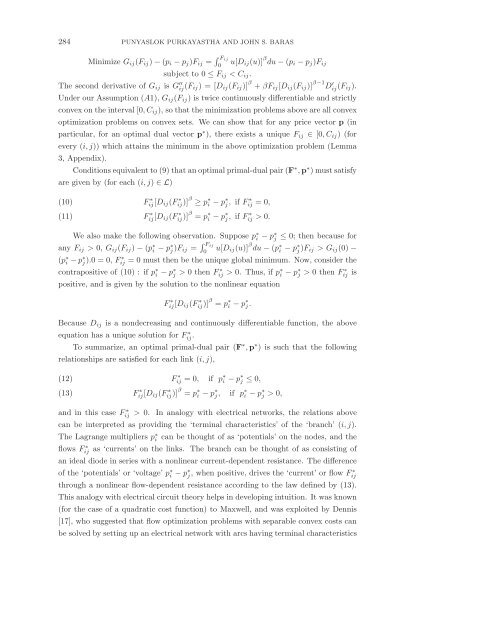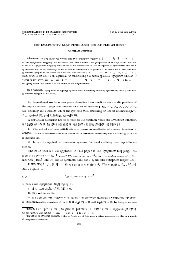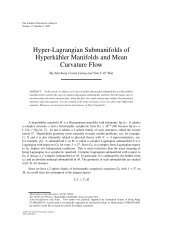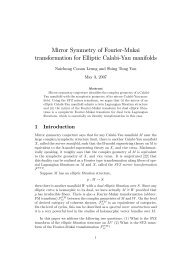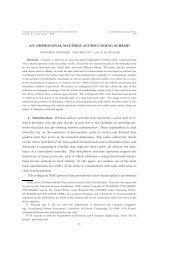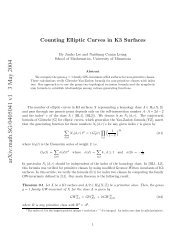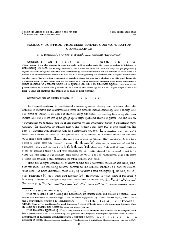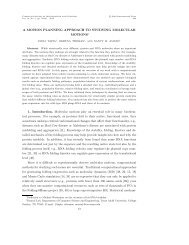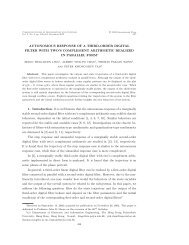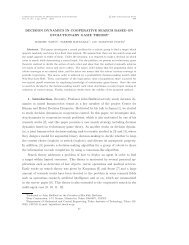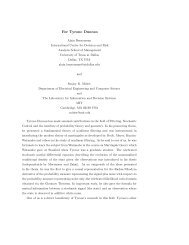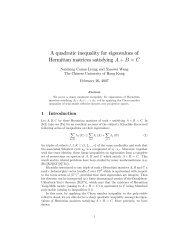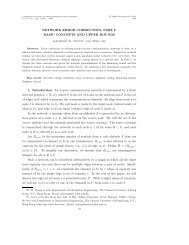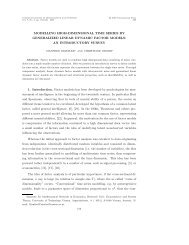AN OPTIMAL DISTRIBUTED ROUTING ALGORITHM USING DUAL ...
AN OPTIMAL DISTRIBUTED ROUTING ALGORITHM USING DUAL ...
AN OPTIMAL DISTRIBUTED ROUTING ALGORITHM USING DUAL ...
Create successful ePaper yourself
Turn your PDF publications into a flip-book with our unique Google optimized e-Paper software.
284 PUNYASLOK PURKAYASTHA <strong>AN</strong>D JOHN S. BARAS<br />
Minimize G ij (F ij ) − (p i − p j )F ij = ∫ F ij<br />
0<br />
u[D ij (u)] β du − (p i − p j )F ij<br />
subject to 0 ≤ F ij < C ij .<br />
The second derivative of G ij is G ′′<br />
ij (F ij) = [D ij (F ij )] β + βF ij [D ij (F ij )] β−1 D ′ ij (F ij).<br />
Under our Assumption (A1), G ij (F ij ) is twice continuously differentiable and strictly<br />
convex on the interval [0, C ij ), so that the minimization problems above are all convex<br />
optimization problems on convex sets. We can show that for any price vector p (in<br />
particular, for an optimal dual vector p ∗ ), there exists a unique F ij ∈ [0, C ij ) (for<br />
every (i, j)) which attains the minimum in the above optimization problem (Lemma<br />
3, Appendix).<br />
Conditions equivalent to (9) that an optimal primal-dual pair (F ∗ ,p ∗ ) must satisfy<br />
are given by (for each (i, j) ∈ L)<br />
(10)<br />
F ∗<br />
ij[D ij (F ∗<br />
ij)] β ≥ p ∗ i − p ∗ j, if F ∗<br />
ij = 0,<br />
F ∗<br />
ij [D ij(Fij ∗ )]β = p ∗ i − p∗ j , if F ij ∗ > 0.<br />
(11)<br />
We also make the following observation. Suppose p ∗ i − p∗ j ≤ 0; then because for<br />
any F ij > 0, G ij (F ij ) − (p ∗ i − p∗ j )F ij = ∫ F ij<br />
u[D<br />
0 ij (u)] β du − (p ∗ i − p∗ j )F ij > G ij (0) −<br />
(p ∗ i − p∗ ∗<br />
j ).0 = 0, Fij = 0 must then be the unique global minimum. Now, consider the<br />
contrapositive of (10) : if p ∗ i − p∗ j > 0 then F ij ∗ > 0. Thus, if p∗ i − p∗ j > 0 then F ij ∗ is<br />
positive, and is given by the solution to the nonlinear equation<br />
F ∗<br />
ij [D ij(F ∗<br />
ij )]β = p ∗ i − p∗ j .<br />
Because D ij is a nondecreasing and continuously differentiable function, the above<br />
equation has a unique solution for F ∗<br />
ij .<br />
To summarize, an optimal primal-dual pair (F ∗ ,p ∗ ) is such that the following<br />
relationships are satisfied for each link (i, j),<br />
(12)<br />
(13)<br />
F ∗<br />
ij = 0, if p ∗ i − p ∗ j ≤ 0,<br />
F ∗<br />
ij [D ij(F ∗<br />
ij )]β = p ∗ i − p∗ j , if p∗ i − p∗ j > 0,<br />
and in this case Fij ∗ > 0. In analogy with electrical networks, the relations above<br />
can be interpreted as providing the ‘terminal characteristics’ of the ‘branch’ (i, j).<br />
The Lagrange multipliers p ∗ i can be thought of as ‘potentials’ on the nodes, and the<br />
flows Fij ∗ as ‘currents’ on the links. The branch can be thought of as consisting of<br />
an ideal diode in series with a nonlinear current-dependent resistance. The difference<br />
of the ‘potentials’ or ‘voltage’ p ∗ i − p∗ ∗<br />
j , when positive, drives the ‘current’ or flow Fij<br />
through a nonlinear flow-dependent resistance according to the law defined by (13).<br />
This analogy with electrical circuit theory helps in developing intuition. It was known<br />
(for the case of a quadratic cost function) to Maxwell, and was exploited by Dennis<br />
[17], who suggested that flow optimization problems with separable convex costs can<br />
be solved by setting up an electrical network with arcs having terminal characteristics


